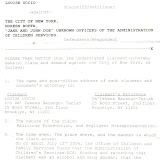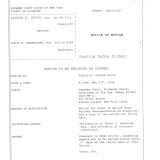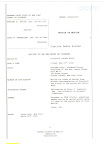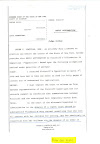
by Jonathan Leo & Jeffrey R. Lacasse is a follow up to their seminal article in PLoS Medicine (2005), in which they debunked the "chemical imbalance" theory of depression.
The "chemical imbalance" theory in psychiatry rests on the observation that mood could be artificially manipulated with drugs-those which raised monoamine levels improved mood, while those which lowered amine levels led to depression, but it remained to be seen if naturally occurring fluctuations in neurotransmitter levels were responsible for, or caused, the ebb and flow of mood levels. As the authors point out, in spite of the enormous amount of money and time that has been spent in the quest to confirm the chemical imbalance theory, direct proof has never materialized. Moreover, during the past several decades, a significant amount of evidence has accumulated which calls the theory's validity into question.
Of particular note, in the two years since publication of their PLoS article, not a single scientific article challenged their conclusion.
Indeed, the chairman of FDA Psychopharmacology Advisory Committee acknowledged that the "chemical imbalance" theory was but a "useful metaphor"--as opposed to a valid hypothesis.
Another credible, evidence-based assessment of the "chemical imbalance" theory is to be found on the website of The Mental Health Service at McGill University:
"The term 'chemical imbalance' is thrown around a lot these days. True conditions caused by chemical imbalances are relatively rare.
All thoughts, feelings and motions in the brain are mediated by the release of chemicals in brain pathways. Every person's brain is unique, leading each of us to have different traits and abilities.
Just because your brain works in a particular way does not mean that you have a chemical imbalance.
A certain amount of sadness, anxiety or other emotional upset is normal, and though we may be able to block these feelings by chemicals, this would tend to dehumanize us. Even when we use medication to help an individual with overwhelming emotions, most of the time this is not to repair a 'chemical imbalance' but simply to help contain symptoms.
"http://www.mcgill.ca/mentalhealth/medication/
However, invalid thought it may be, as Drs. Leo and Lacasse point out the "chemical imbalance" theory has had extraordinary commercial value for both the pharmaceutical industry and psychiatry:
"With the advent of the chemical imbalance theory, the companies were no longer just providing soothing tonics, they were now providing medications to treat diseases, as exemplified by an early SSRI advertisement stating: "When serotonin is in short supply, you may suffer from depression." The wording here is all-important. The advertisement takes a correlation between serotonin shortage and psychological stress-and even this is highly questionable and unverifiable in any individual case-and makes a leap of faith to the conclusion that depression is caused by a serotonin imbalance, not that psychological stress impacts the serotonin system.
And the marketing did not stop with depression; eventually we were told that whatever our problems might be, whether anxiety, excessive shyness, depression, or the inability to pay attention, the underlying cause was a faulty transmitter level which could be rectified with a pill.
A 2005 survey from the Harvard School of Public Health reported that nearly half of all Americans will at some point develop a mental illness, presumably from a chemical imbalance, with 29% developing an anxiety disorder and 20% a mood disorder.
"The "chemical imbalance" theory has provided promoters of psychoactive "feel good" prescription drugs with the means for distancing their products from illicit street drugs whose chemical action is almost indistinguishable. Whereas drugs used to "take the edge off" stress are typically considered street drugs and are consumed by "users" or "addicts," substances used to rectify a "chemical imbalance" can be called medications--and these are legitimately consumed by patients.
A fly in the ointment occurred when Ricky Williams, the star running back for the Miami Dolphins who had been "diagnosed" with Social Anxiety Disorder, and for several years was paid by GlaxoSmithKline to promote Paxil for anxiety disorder, was described in 2002, by People magazine, as suffering from a "depression-like chemical imbalance that affects roughly three million Americans." Williams tested positive for marijuana on several occasions. But while his marijuana use was frowned upon, his use of Paxil was considered acceptable. One was a medication supposed to treat a chemical imbalance, while the other was a drug signaling a lack of willpower. However, Williams' contract with Glaxo came to a sudden halt in 2004, when he stated that marijuana was ten times better than Paxil. What got him into hot water, Drs. Leo and Lacasse, note, was not so much praising the competition, but rather putting his sponsor's "medication" in the same category as an illicit drug. Williams threatened the assumption underlying the conventional unsupportable divide between legal and illegal drug use. His juxtaposition threatened the most powerful industries--including professional sports, the pharmaceutical industry, psychiatry, and the mass media.
Another fly in the ointment raising questions about the validity of the dividing line between prescribed and illicit psychoactive substances, is a recent controlled clinical trial conducted by researchers at Johns Hopkins. The researchers ostensibly tested the "Mystical" effects of psilocybin, the active ingredient in mushrooms which is an illegal drug that causes hallucinations. However, two months after the trial they found that "79% of those prescribed psilocybin reported moderately or greatly increased levels of life satisfaction compared with those given a placebo. A majority said their mood, attitudes and behaviors had changed for the better." http://www.hopkinsmedicine.org/Press_releases/2006/07_11_06.html
No SSRI clinical trial had that high a rate of long-lasting improvements in mood, attitude and behavior.
The authors sent inquiries to reporters who mentioned the "chemical imbalance" theory as if it had been proven, asking for citations of such proof. The responses--or lack of responses--and the biased, pro-industry reporting about mental health treatments, are no less troubling than the biased reporting in the New York Times about the events leading up to the Iraq War.
"In hindsight, as the Times editors now acknowledge (5/326/04), Judith Miller's war coverage was overly one-sided. Her fundamental flaw could be described as a lack of professional skepticism toward the Bush administration, as she willingly parroted what those pushing for war were saying, while giving little credence to the stance of the other side. Writing in the New York Review of Books, Michael Massing commented that the Times and Miller's reporting were examples of media "submissiveness."This depiction could just as well apply to the media's reporting of mental health issues.
As just one example, in some cases, the media still go to the people responsible for the original problems. For instance, several of the researchers involved with the studies of SSRIs in children are still cited in the press even though the following information has come out about their published studies: they downplayed the suicide risk; they exaggerated the benefits; and the papers published under their names were actually written by ghostwriters paid by the pharmaceutical industry.
The Times editors have acknowledged both the problems with Miller's reporting and their own lack of editorial oversight of her. It remains to be seen if members of the media will ever look inward and reflect on their role in the promotion of the chemical imbalance theory. (For those familiar with the New York Times' coverage of mental health issues over the past 10 years, it is refreshing that after a series of health reporters who essentially abdicated their role as investigative journalists, there is a newer group of Times reporters with more skepticalinclination..."
Both articles by Jonathan Leo and Jeffrey Lacasse are freely accessible. http://www.springerlink.com/content/u37j12152n826q60/fulltext.pdf
and http://medicine.plosjournals.org/perlserv/?request=get-document&doi=10.1371/journal.pmed.0020392
ALLIANCE FOR HUMAN RESEARCH PROTECTIONPromoting Openness, Full Disclosure, and Accountabilityhttp://www.ahrp.org/ and http://ahrp.blogspot.com/
Contact: Vera Hassner Sharav veracare@ahrp.org
212-595-8974
The "chemical imbalance" theory in psychiatry rests on the observation that mood could be artificially manipulated with drugs-those which raised monoamine levels improved mood, while those which lowered amine levels led to depression, but it remained to be seen if naturally occurring fluctuations in neurotransmitter levels were responsible for, or caused, the ebb and flow of mood levels. As the authors point out, in spite of the enormous amount of money and time that has been spent in the quest to confirm the chemical imbalance theory, direct proof has never materialized. Moreover, during the past several decades, a significant amount of evidence has accumulated which calls the theory's validity into question.
Of particular note, in the two years since publication of their PLoS article, not a single scientific article challenged their conclusion.
Indeed, the chairman of FDA Psychopharmacology Advisory Committee acknowledged that the "chemical imbalance" theory was but a "useful metaphor"--as opposed to a valid hypothesis.
Another credible, evidence-based assessment of the "chemical imbalance" theory is to be found on the website of The Mental Health Service at McGill University:
"The term 'chemical imbalance' is thrown around a lot these days. True conditions caused by chemical imbalances are relatively rare.
All thoughts, feelings and motions in the brain are mediated by the release of chemicals in brain pathways. Every person's brain is unique, leading each of us to have different traits and abilities.
Just because your brain works in a particular way does not mean that you have a chemical imbalance.
A certain amount of sadness, anxiety or other emotional upset is normal, and though we may be able to block these feelings by chemicals, this would tend to dehumanize us. Even when we use medication to help an individual with overwhelming emotions, most of the time this is not to repair a 'chemical imbalance' but simply to help contain symptoms.
"http://www.mcgill.ca/mentalhealth/medication/
However, invalid thought it may be, as Drs. Leo and Lacasse point out the "chemical imbalance" theory has had extraordinary commercial value for both the pharmaceutical industry and psychiatry:
"With the advent of the chemical imbalance theory, the companies were no longer just providing soothing tonics, they were now providing medications to treat diseases, as exemplified by an early SSRI advertisement stating: "When serotonin is in short supply, you may suffer from depression." The wording here is all-important. The advertisement takes a correlation between serotonin shortage and psychological stress-and even this is highly questionable and unverifiable in any individual case-and makes a leap of faith to the conclusion that depression is caused by a serotonin imbalance, not that psychological stress impacts the serotonin system.
And the marketing did not stop with depression; eventually we were told that whatever our problems might be, whether anxiety, excessive shyness, depression, or the inability to pay attention, the underlying cause was a faulty transmitter level which could be rectified with a pill.
A 2005 survey from the Harvard School of Public Health reported that nearly half of all Americans will at some point develop a mental illness, presumably from a chemical imbalance, with 29% developing an anxiety disorder and 20% a mood disorder.
"The "chemical imbalance" theory has provided promoters of psychoactive "feel good" prescription drugs with the means for distancing their products from illicit street drugs whose chemical action is almost indistinguishable. Whereas drugs used to "take the edge off" stress are typically considered street drugs and are consumed by "users" or "addicts," substances used to rectify a "chemical imbalance" can be called medications--and these are legitimately consumed by patients.
A fly in the ointment occurred when Ricky Williams, the star running back for the Miami Dolphins who had been "diagnosed" with Social Anxiety Disorder, and for several years was paid by GlaxoSmithKline to promote Paxil for anxiety disorder, was described in 2002, by People magazine, as suffering from a "depression-like chemical imbalance that affects roughly three million Americans." Williams tested positive for marijuana on several occasions. But while his marijuana use was frowned upon, his use of Paxil was considered acceptable. One was a medication supposed to treat a chemical imbalance, while the other was a drug signaling a lack of willpower. However, Williams' contract with Glaxo came to a sudden halt in 2004, when he stated that marijuana was ten times better than Paxil. What got him into hot water, Drs. Leo and Lacasse, note, was not so much praising the competition, but rather putting his sponsor's "medication" in the same category as an illicit drug. Williams threatened the assumption underlying the conventional unsupportable divide between legal and illegal drug use. His juxtaposition threatened the most powerful industries--including professional sports, the pharmaceutical industry, psychiatry, and the mass media.
Another fly in the ointment raising questions about the validity of the dividing line between prescribed and illicit psychoactive substances, is a recent controlled clinical trial conducted by researchers at Johns Hopkins. The researchers ostensibly tested the "Mystical" effects of psilocybin, the active ingredient in mushrooms which is an illegal drug that causes hallucinations. However, two months after the trial they found that "79% of those prescribed psilocybin reported moderately or greatly increased levels of life satisfaction compared with those given a placebo. A majority said their mood, attitudes and behaviors had changed for the better." http://www.hopkinsmedicine.org/Press_releases/2006/07_11_06.html
No SSRI clinical trial had that high a rate of long-lasting improvements in mood, attitude and behavior.
The authors sent inquiries to reporters who mentioned the "chemical imbalance" theory as if it had been proven, asking for citations of such proof. The responses--or lack of responses--and the biased, pro-industry reporting about mental health treatments, are no less troubling than the biased reporting in the New York Times about the events leading up to the Iraq War.
"In hindsight, as the Times editors now acknowledge (5/326/04), Judith Miller's war coverage was overly one-sided. Her fundamental flaw could be described as a lack of professional skepticism toward the Bush administration, as she willingly parroted what those pushing for war were saying, while giving little credence to the stance of the other side. Writing in the New York Review of Books, Michael Massing commented that the Times and Miller's reporting were examples of media "submissiveness."This depiction could just as well apply to the media's reporting of mental health issues.
As just one example, in some cases, the media still go to the people responsible for the original problems. For instance, several of the researchers involved with the studies of SSRIs in children are still cited in the press even though the following information has come out about their published studies: they downplayed the suicide risk; they exaggerated the benefits; and the papers published under their names were actually written by ghostwriters paid by the pharmaceutical industry.
The Times editors have acknowledged both the problems with Miller's reporting and their own lack of editorial oversight of her. It remains to be seen if members of the media will ever look inward and reflect on their role in the promotion of the chemical imbalance theory. (For those familiar with the New York Times' coverage of mental health issues over the past 10 years, it is refreshing that after a series of health reporters who essentially abdicated their role as investigative journalists, there is a newer group of Times reporters with more skepticalinclination..."
Both articles by Jonathan Leo and Jeffrey Lacasse are freely accessible. http://www.springerlink.com/content/u37j12152n826q60/fulltext.pdf
and http://medicine.plosjournals.org/perlserv/?request=get-document&doi=10.1371/journal.pmed.0020392
ALLIANCE FOR HUMAN RESEARCH PROTECTIONPromoting Openness, Full Disclosure, and Accountabilityhttp://www.ahrp.org/ and http://ahrp.blogspot.com/
Contact: Vera Hassner Sharav veracare@ahrp.org
212-595-8974























No comments:
Post a Comment